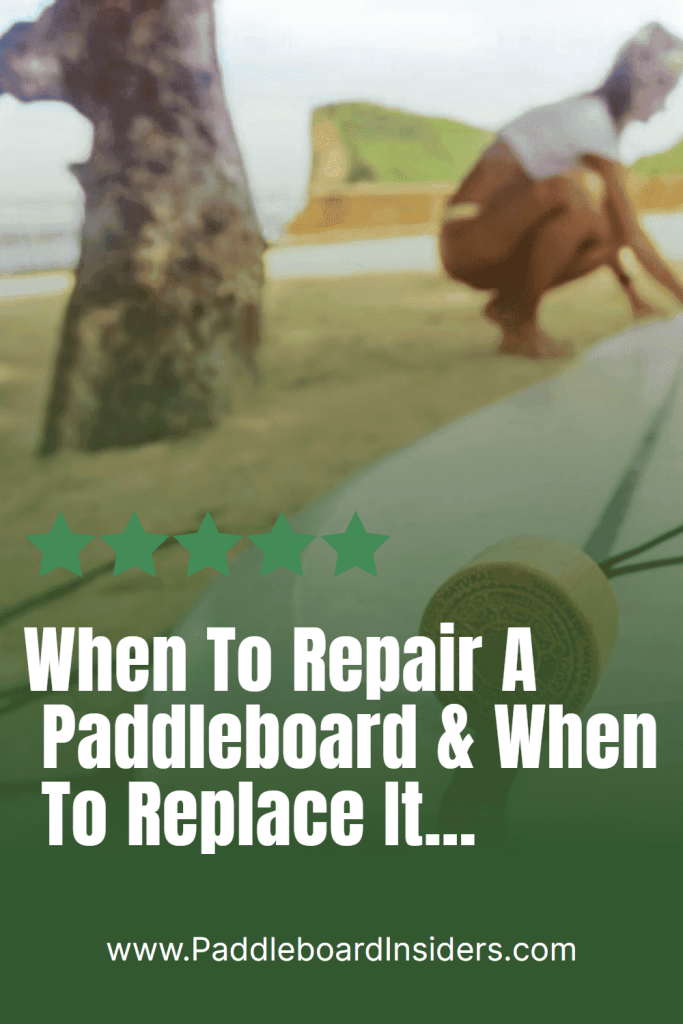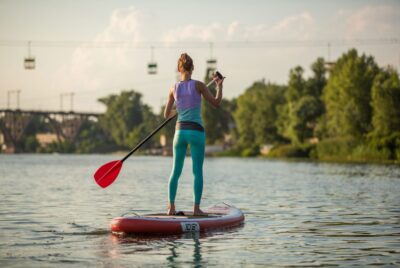When To Repair A Paddleboard & When To Replace It
*We may earn a commission for purchases made using our links. Please see our disclosure to learn more.
When I spend a lot of time on the water, I often find myself facing a dilemma: when is paddleboard repair the best option… and when is it time to bid your faithful SUP farewell and invest in a new one?
This is the question that I am hoping to answer in this article, so keep reading to find out more 🙂
| Looking for our best paddle board product recommendations? Check the Paddleboard Insiders Buyer Guides |
The first thing that we need to cover is what are the actual signs of paddleboard damage that you need to be aware of?
Table Of Contents
Paddleboard Repair: Signs of Paddleboard Wear
IDENTIFYING MINOR WEAR
Before deciding whether to repair or replace, it’s essential to understand the signs of wear on your paddleboard. Minor wear and tear can be a normal part of a paddleboard’s life.
These are some common signs to look out for:
Scratches and Dings
- Scratches on the board’s surface.
- Small dings or chips in the material (if using a hard board)
- Minor discoloration.
Faded Graphics and Discoloration
- Graphics and colors starting to fade.
- Discoloration from prolonged sun exposure.
- Signs of general aesthetic wear.
Loose or Damaged Fins
- Fins becoming loose or showing signs of damage.
- Impact on stability and tracking.
- Difficulty in maintaining a straight course.
Paddleboard fins are often a really misunderstood topic, so here is everything you need to know about them.
All of these factors are things that can be easily overlooked and you probably don’t need to repair the board because of these.
Like I said – it’s part of regular use so you can expect for these things to happen.
If you have any questions then you can just pop into any paddleboard store and they will be able to talk about their repair options but it shouldn’t be expensive.
RECOGNIZING SIGNIFICANT DAMAGE
While minor wear can often be overlooked, significant damage should raise red flags. These signs indicate that your paddleboard may be beyond simple repairs:
Cracks or Punctures
- Visible cracks in the board’s body.
- Punctures that extend through the material.
- Leaks that can’t be easily patched.
Delamination (Separation of board layers)
- Layers of the board separating or bubbling.
- Loss of rigidity and structure.
- Decreased performance and safety concerns.
Bent or Broken Components
- Bent, cracked, or broken paddle shaft.
- Damaged handle or deck pad.
- Any component that compromises functionality.
These are all major factors that can not only impact your paddleboarding experience, but they are also a safety risk that you want to deal with.
Paddleboard Repair: Everything You Need To Know
Now that you have assessed your paddleboard for damage and decided whether its a minor problem or a major problem
You want to assess whether you’re going to repair it or not (and whether you can do the repair job yourself).
DIY REPAIRS
If you’re dealing with minor wear and tear, you might consider tackling the repairs yourself. DIY repairs can be cost-effective and satisfying if you’re handy.
If you have an inflatable paddleboard then you can use this guide to repair your SUP:
This is my favorite repair product to get the job done:
Best For Transparent Repairs: AquaPro Liquid Repair Kit
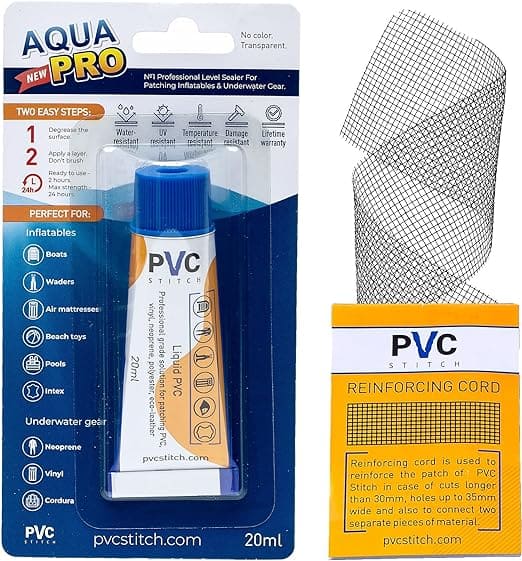
Where To Buy: Amazon
Key Features & Benefits:
– Transparent reinforcing cord lets you reinforce the PVC stitching
– Allows you to use your board within 2 hours (24 is recommended though)
– Very budget friendly 🙂
– Easy to use
You can use this and the instructional video for a good paddleboard repair job. Just make sure that you have properly cleaned and degreased the surface of your paddleboard BEFORE doing this (that’s a mistake that I made in the past).
Replacing Fins
If your fins are damaged then this is a really easy problem to solve (count yourself lucky)
| Here’s everything that you need to know about paddleboard fins: Choosing Paddleboard Fins Like a Pro: A Comprehensive Buyer’s Guide |
Repairing Scratches
If you have a hard (epoxy) paddleboard then you can follow the following steps to repair the scratches.
1: Sand down scratches gently with fine-grit sandpaper.
2: Apply a matching touch-up paint or gel coat.
3: Buff and polish for a smooth finish.
PROFESSIONAL REPAIRS
For significant damage or if you’re unsure of your DIY skills, seeking professional help is advisable. Professional repair services can handle complex issues like delamination or severe cracks. Benefits of professional repairs include:
Expertise and Quality
- Skilled technicians with experience in paddleboard repairs.
- Use of specialized tools and materials.
- Ensures safety and longevity.
Warranty Preservation
- Maintains any existing warranty on your paddleboard.
- Helps protect your investment in high-quality equipment.
- Peace of mind in knowing the job is done right.
So if that sounds good to you then it’s worth getting a professional job done. You can get more information at any local stores that sell paddleboards in your area.
Paddleboard Repair: When to Replace Your Paddleboard
Age plays a significant role in the decision to repair or replace. Paddleboards, like all equipment, have a limited lifespan.
The #1 biggest factor that tells you if you should replace it instead of doing a paddleboard repair is the age of the SUP. Paddleboards degrade over time, and generally a well maintained paddleboard will last anywhere from 5-10 years.
But if you use your board alot, or have improved in your abilities then it might be a good idea to replace it.
Sometimes, something happens and the damage is simply too extensive to repair, and it’s evident that it’s time for a replacement.
Obviously you want to get quotes for repairs before you buy a new board, but if the cost of repair is higher then it’s time to take the leap into a new SUP 🙂
Here are some of my favorite paddleboards right now:
Top Inflatable Paddleboard: ISLE Pioneer 10’6″ Paddleboard
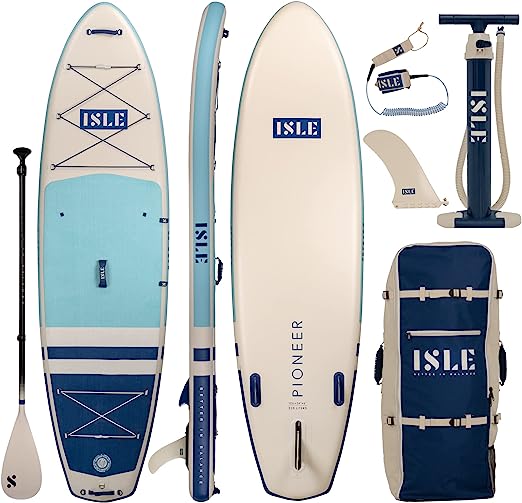
Where To Buy: Amazon
Key Features:
– Allows up to 285lb in weight
– 10’6″ in size
– Comes with bag, leash, fin and paddle
– 2 Year warranty on materials
– 60 day return policy
ISLE really makes good paddleboards and they are well worth looking into. So this is my favorite board, but in close second is the Atoll 11″ iSUP
Runner Up: Atoll 11″ iSUP
Where To Buy: Amazon
Key Features:
– Allows up to 400lb in weight
– 11’0″ in size
– Comes with bag, leash, fin and paddle
– 2 year warranty on materials
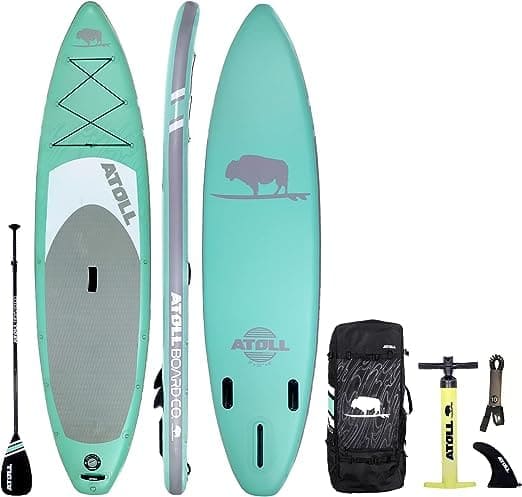
If you want some more options to choose from then these are my favorite paddleboarding brands.
| These are the paddleboarding brands that you want to invest into. Best Paddleboard Brands: Our Top Recommendations For 2024 |
Now, you might already know this – but the best way to prevent all of this happening in the first place is to take better care of your paddleboard.
Here’s how you can do that.
Paddleboard Repair: How To Maintain Your SUP
It’s actually really easy to take proper care of a paddleboard and most people think that this takes a lot of effort… but that’s false!
You can take exceptional care for your paddleboard in just 5-10 minutes.
All you need to do is:
- Regularly clean your paddleboard
- Store it properly
- Get a good protective cover or bag
- Regularly inspect for damage
That’s it!
Let’s dive into how to actually do it 🙂
REGULAR CLEANING
When it comes to cleaning, you want to be rinsing off any salt or grime from your board after every use ideally. I know that this is a lot of effort but if you’re looking to protect your board for the long term then it’s a really good idea.
Here is a really good instructional video on how to do proper maintenance on your SUP:
Summary:
- Rinse your board after each use.
- Use a mild soap to remove saltwater and debris.
- Keep it dry to prevent mold and mildew.
PROPER STORAGE
TIP 1: You want to make sure that you store your paddleboard properly in a cool, dry place to avoid mould forming because that can destroy the infrastructure of your board.
When it comes to storage, there are a few great options for you to look into:
Best Freestanding Stand: Suspenz Double-Up SUP Stand

Where To Buy: Amazon
Key Features & Benefits:
– You can put them anywhere so it’s super easy to find a great storage space for your boards
– You can fit 2 different SUP’s on these racks.
– They are easy to take apart & travel with, so that you can store your SUP’s on the move.
– Cushioning keeps your boards safe and secure without getting damaged.
If you travel alot then this is also a really good option that is super portable.
Best Budget Portable Storage Rack: Best Marine Folding Kayak Stand
Where To Buy: Amazon
Key Features & Benefits:
– You don’t have to assemble anything – they just fold out and store your board.
– They are lightweight (2.5lbs each) so you can easily transport them.
– They can hold up to 150lbs or weight.
– These are really good for maintenance and spraying down your SUP after use.
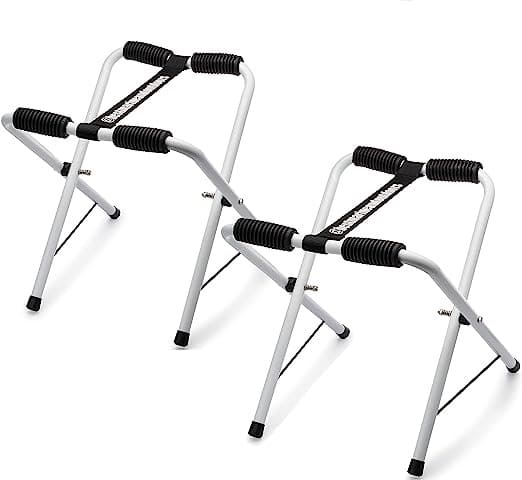
TIP 2: Avoid exposure to sunlight for long periods of time because this will bleach and weaken the materials along with getting rid of your nice decals.
TIP 3: Finally you want to use a board bag or board sock to ensure that you can avoid scratches and dings.
Here are some examples of my favorite board bags and socks:
Best Everyday Bag: Ho Stevie! SUP Sock Cover
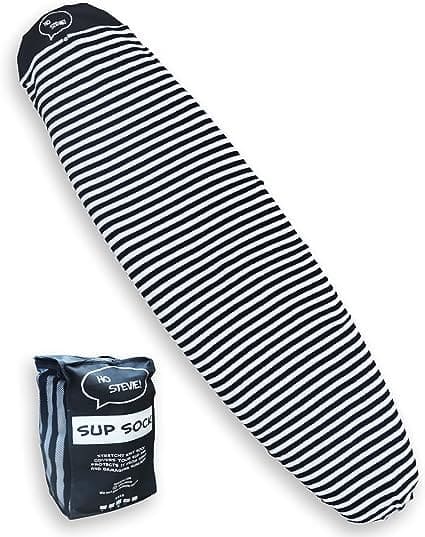
Where To Buy: Amazon
Key Features & Benefits:
– Stretch fabric covers all sizes of paddleboards
– Thick fabric protects your board from scrapes and bumps.
– UV Resistant to protect your board from sun damage
– 100% Money back guarantee for 30 days
Or if you’re more interest in something that will give it more protection that a proper paddleboard bag is the right purchase for you.
Best Travel Bag: SUP-NOW Paddleboard Bag With Wheels
Where To Buy: Amazon
Key Features & Benefits:
– Universal fit so it will fit all inflatable paddleboards
– Top-quality materials and includes wheels for easier transportation
– You can use it as a backpack or as a wheelie bag
– 100% Money back guarantee
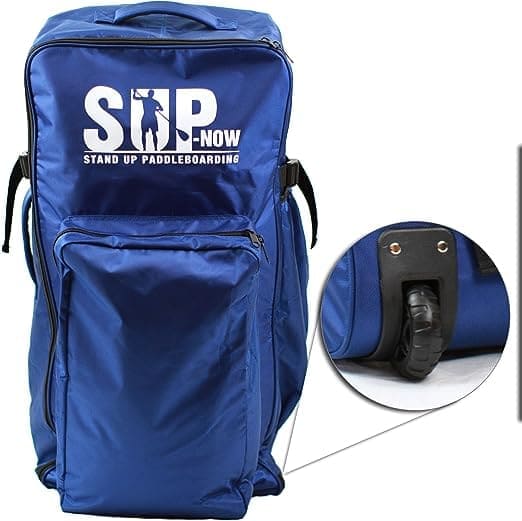
Summary:
- Store your board in a cool, dry place.
- Avoid prolonged exposure to direct sunlight.
- Use a board bag or cover for added protection.
INSPECTING FOR DAMAGE
This might seem obvious, but it’s a good idea to regularly look for damage on your paddleboards. Look for things like scratches, dents and frayed leashes.
It’s often a smart move to get these kind of issues dealt with quickly because if you leave them alone then they become a much bigger problem later on.
Reach out to a local paddleboard store for repair quotes and information if they are a problem.
Summary:
- Routinely inspect your board for signs of wear.
- Address minor issues promptly to prevent major damage.
- Follow the manufacturer’s guidelines for care.
Conclusion
Deciding whether to repair or replace your paddleboard is a tough decision for anyone. Paddleboards can be expensive so if you can repair it then by all means do it 🙂 By assessing the signs of wear, considering repair options, and factoring in cost and environmental impact, you can make an informed choice that suits your needs.
| Looking for insider guides to some amazing paddle boarding locations? Check the Paddleboard Insiders Location Guides |
FAQs
How often should I inspect my paddleboard for damage?
Regularly inspect your paddleboard before and after each use, and perform a more thorough inspection at least once a month, especially if you use it frequently.
Can minor dings and scratches be safely ignored?
Minor dings and scratches can often be repaired to prevent further damage, but ignoring them for too long can lead to more extensive problems.
What are the environmental benefits of repairing vs. replacing a paddleboard?
Repairing your paddleboard extends its life and reduces waste, making it a more environmentally friendly choice compared to replacing it.
Is it worth investing in a more expensive, durable paddleboard to begin with?
Investing in a high-quality paddleboard from the start can save you money in the long run, as it’s likely to be more durable and require fewer repairs.
Can I repair a paddleboard myself if I’m not very handy?
Some minor repairs can be done by beginners with the right guidance and tools, but for more significant damage, it’s best to seek professional assistance to ensure safety and effectiveness.
